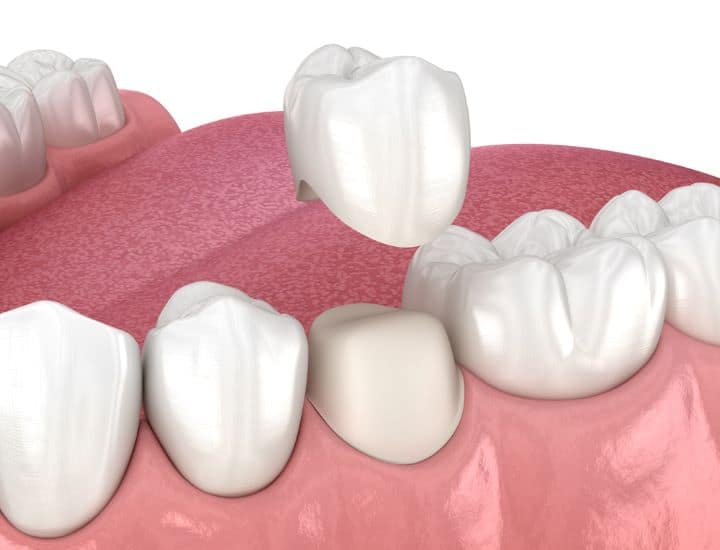Are you looking for an alternative and comfortable way to straighten your teeth?
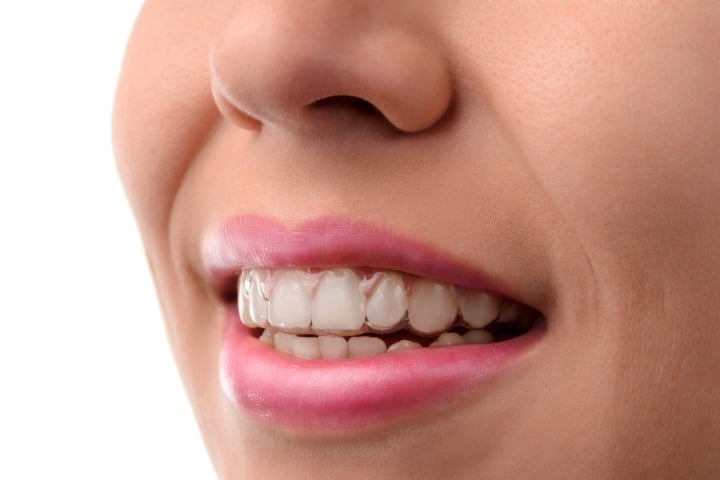
Clear braces are a contemporary take on traditional metal braces. Much like normal braces, clear braces can correct orthodontic issues and align teeth but clear-type braces are less noticeable than metal braces made of metal and much more pleasant-looking to the eyes.
Say goodbye to pesky metal brackets and wires and say hello to a new age of braces where moving teeth without causing nicks and cuts is the new standard.
Clear Dental Braces: Everything you need to know about clear braces
Clear dental braces, similar to metal braces are designed to straighten teeth but they come with a catch – they are virtually invisible. Clear braces, also rightfully known as invisible braces, are discreet and more aesthetically pleasing.
Many orthodontists recommend clear braces for adults and teens due to their special “incognito” feature, especially during social events.
They can be applied to correct a wide range of orthodontic anomalies, including crooked, crowded, or gapped teeth.
Clear braces are the best option when…
Clear braces are incredibly versatile in their function and can be used to manage a wide range of misalignment problems.
While it may not be the first choice in some severe cases of malocclusion, your orthodontist may offer you clear braces to correct the following teeth issues:
- Crooked teeth (occurs when two or more teeth overlap unnaturally)
- Overbites (occurs when your top front teeth sit beyond your lower front teeth)
- Underbites (occurs when your lower front teeth extend beyond your top front teeth)
- Crossbites (occurs when your lower teeth are outside of your upper teeth)
- Open bites (occur when your upper and lower teeth do not touch)
- Crowding (occurs when there is inadequate space for all teeth in the arch)
- Gaps or spaces (occur when there are uneven gaps between your teeth)
- Minor rotation of teeth
When your teeth are improperly aligned, it becomes difficult for you to clean your teeth. This can potentially impact your oral health, increasing your risk of cavities and gum disease.
Clear aligners improve your oral health and function while at the same time boosting your confidence and self-esteem.
Types of Invisible Braces
Recent advancements in technology have prompted the development of orthodontics and subsequently, the creation of clear orthodontic aligners.
Clear-type braces include a rather assorted selection, catering to any age group, young or old.
Clear braces can come in any shape, size, or form, each with its unique features and benefits. Here we delve into three common types of clear braces that your orthodontist may offer to align your unruly teeth.
- Ceramic braces: They are fixed appliances that use clear brackets and attachments to straighten crooked teeth.
- Lingual Braces: They are fixed appliances where the brackets and wires are placed on the inside of the teeth.
- Invisalign: It consists of a series of clear aligners that are custom-made to the patient’s mouth and are replaced periodically. They are the only removable option among the three clear braces.
Ceramic Braces
As the name suggests, ceramic clear braces are made of ceramic porcelain.
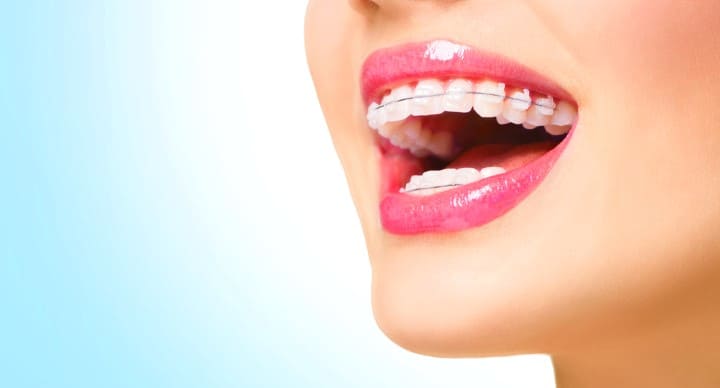
They follow the same principles as conventional braces: Brackets and wires are fixed or attached to your teeth to align them into their new positions.
What makes these braces clear is that they use clear ceramic brackets with white or frosted wires to type the appliance together.
They blend in with the color of your natural teeth, which is why these braces are often called esthetic braces.
- How do these braces work?
Ceramic-formed braces work similarly to metal braces.
Your dentist glues clear brackets to the front of the teeth using special cement.
Once these pieces are in place, he attaches a tooth-colored wire to the metal slots by anchoring the wire to your back teeth using metal bands.
Finally, clear rubber bands or elastics are added to help hold the archwires firmly in place.
Despite its discreet appearance, these braces function in the same way as conventional braces.
When the archwires are activated, the appliance helps gradually move your teeth into their new positions.
- How much do these braces cost?
In general, they cost between $4,000 and $7,000. This pricetag includes pre-treatment consultations, x-rays, office visits, and retainers that are prescribed after the treatment is complete.
- Pros and cons
They offer multiple advantages and disadvantages:
- Pros
- Appearance: Consists of tooth-colored brackets that make them less noticeable during day-to-day use.
- Comfort of wear: These brackets are slightly smaller than metal brackets and are less cumbersome to wear
- Cost-effective: Compared to other invisible braces, they are relatively affordable.
- Effective treatment: Can treat mild to moderate misalignment.
- Durable: Resistant to breakage.
- Cons
- Discoloration: The clear elastic ties are prone to discoloration, especially upon consuming tea, coffee, or wine.
- Long treatment time: On average, they take about 18 to 36 months to straighten teeth.
- Fixed appliance: They can only be removed by a professional.
Lingual Braces
Lingual braces are technically not “clear” braces because these braces require metal attachments to function, but they function almost analogously to traditional braces.
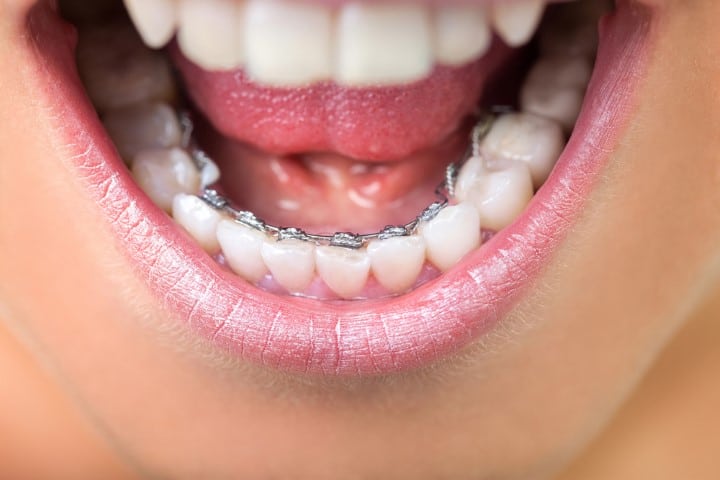
Much like traditional metal braces, these lingual types are constructed out of the same metal elements, but with a rather peculiar twist.
Metal brackets and metal wires are key components of lingual-type braces similar to conventional braces, except they are placed on the inside of the teeth instead of the outside. This makes them “invisible” to any peering on-lookers.
- How do these braces work?
They are similar to conventional braces in the way they function. A trained orthodontist uses cement to bond the metal pieces to the inside of your teeth closest to your tongue.
They apply a continuous yet gradual pressure on your teeth and help them move into alignment. These braces require a bit of tightening every month or so as the teeth are gently shifted.
- How much do these braces cost?
They cost $10,000 on average from the start to the end of the treatment.
- Pros and cons
They offer multiple advantages and disadvantages:
- Pros
- Appearance: Cannot be seen from the outside and thus are completely invisible.
- Confidence: Great for self-conscious individuals.
- Effective treatment: Can treat mild to moderate misalignment.
- Cons
- Difficult to clean: Sticky and chewy foods can get stuck in the nooks and crannies of the braces frame.
- Expensive: More expensive than other braces.
- Ineffective for severe cases: Will not work for complex malalignment cases.
- Uncomfortable to wear: Regular contact with the tongue may cause injuries and even cause you to develop a lisp.
- Longer treatment duration: Regular adjustments take longer than normal braces.
Invisalign aligners
Clear aligners are a brand of medical-grade, removable, transparent trays that are designed to fit snugly over your teeth, covering the upper and lower teeth.
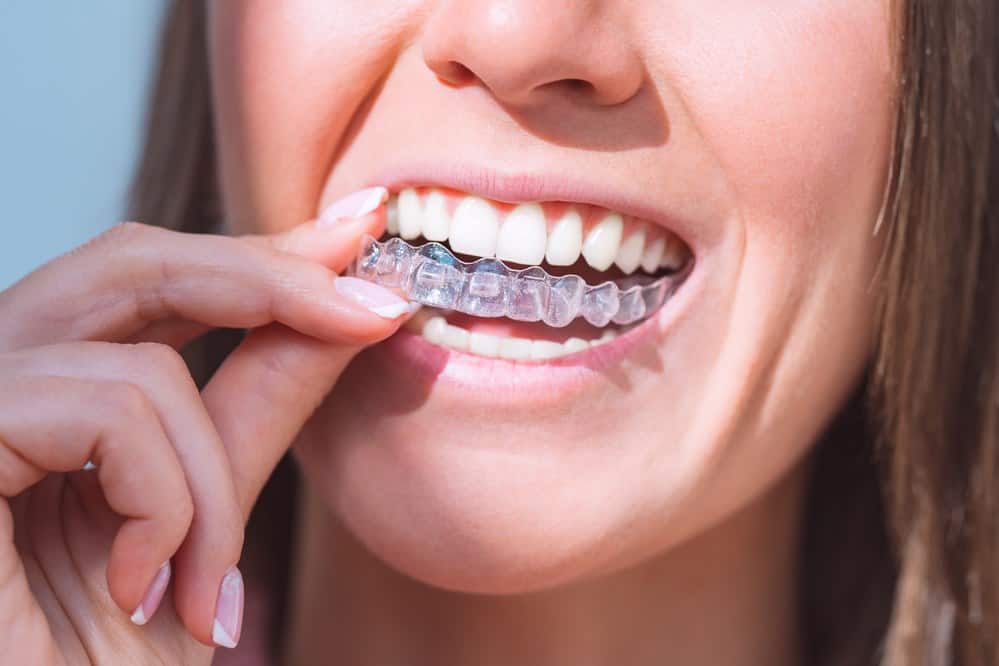
Invisalign is a specific brand of clear aligner system that is orthodontist-approved.
These braces do not make use of metal attachments or devices to force teeth to move back to their original and orthodontically ideal positions. These plastic trays are modeled as per the specific requirements of the patient.
They are made of a soft, flexible plastic called SmartTrack® that has been patented by the Invisalign® brand. The patient is started off with a set of aligners which are replaced with new aligners every 2 weeks as the teeth begin to shift.
The number of aligner sets that each person receives to straighten their teeth will depend on the complexity of their case. The Invisalign system typically consists of a series of 18 to 30 custom-made aligners.
- How do these clear aligners work?
Instead of taking impressions of your teeth, your dentist will use a digital intraoral scanner to take scans of your teeth and gums. These scans are then transferred to software to create a digital replica of your teeth.
Your orthodontist will develop a personalized treatment plan for you.
Using the software, they can move the ideal locations of your teeth’s digital image and predict each progressing stage between your current and desired teeth positions.
Finally, a real-life 3D replica of your digital scans is constructed. Upon wearing these braces, they apply consistent and gentle pressure to your teeth, gradually breaking down and remodeling bone in the direction of the pressure.
- Guide to wearing your Invisalign aligners
For optimal results, clear plastic aligners should be worn for at least 22 hours per day.
You should only remove your aligners during meals or when you need to clean them. Besides these specifications, you must wear your aligners stringently.
Not following the recommendations of wear set by your orthodontist can enormously affect your treatment process as well as cause extension of the treatment and undesired outcomes.
- What is the cost of Invisalign treatment?
The cost of Invisalign treatment depends on the severity of your teeth’s condition and the ultimate goals set by the dental professional. On average, this treatment can range anywhere from $3,000 to $12,000.

- Pros and cons
It offers multiple advantages and disadvantages:
- Pros
- Appearance: Almost completely invisible to the naked eye.
- Confidence: Boosts self-esteem among growing teen or adult patients.
- User-friendly: Aligners are made of flexible plastic, they are easy to remove and pop back on.
- No worries about food: You can enjoy your favorite foods including sticky, chewy, or crunchy foods without worrying about them getting stuck.
- Oral care: Easy to clean since clear aligners are removable.
- Value-added time: You can visit your dentist once every 8 weeks, instead of every month as with conventional braces.
- Shorter treatment time: They take only 6-18 months to complete.
- Unlimited customization options: Orthodontists will design the aligners to completely suit the patient’s unique needs.
- You are in on the fun: Since you can see the simulation of the final results through the treatment-planning software, you will know what your result will look like.
- Affordable: They cost somewhere within the range of conventional braces.
- Effective: Orthodontists use these aligners to correct mild to moderate malalignment issues.
- Minimal Pain: Comparatively painless to other braces options.
- Predictable outcome: Offers a visual timeline for each stage of the treatment, giving your dentist a clear picture of the result.
- Cons
- Ineffective for severe cases: Invisalign may not work for severe cases of malalignment like rotation.
- Not made for kids: These are not available for children, only adults and teens.
- Can be lost: You can easily lose the aligners and it is also expensive to replace.
Does your dental insurance cover the cost of clear braces?
If you and your dentist have decided that clear braces or clear aligners are the right fit for you, you cannot be deterred by the cost of the treatment.

Most dental offices near you offer various options by which you can pay for your braces.
Orthodontic offices may provide various insurance plans with coverage for orthodontic treatment. The first type would be in-house financing wherein you make a small down payment and pay the remaining balance in monthly installments.
You can choose any payment method to pay your dues including check/cash, health savings accounts, and credit cards. Most practices also offer a zero-interest payment plan that makes getting braces all the more affordable.
Another plan includes offices providing a 5 to 10% discount for their patients that pay the full balance upfront. In this way, you can save hundreds of dollars from your clear braces treatment.
Of course, not everyone can make such a huge down payment or pay upfront. Dental insurance may not pay for the entire cost of treatment but will pay for a certain percentage typically covering 50% of the cost of ortho treatment.
The American Association of Orthodontics (AAO) endorses companies that specialize in financing dental procedures and that include clear braces. Lending Club and Care Credit offer loans with low-interest rates to accommodate the cost of your ortho care.
How to take care of your invisible aligners?
Here are a few tips on what you should and should not do to take proper care of your new braces.
- Oral care
Maintaining oral health and hygiene is a quintessential part of wearing braces. You can clean your teeth and aligners with the following tips:
- Brush your teeth twice a day with fluoridated toothpaste.
- Floss your teeth at least once a day to clean between your braces frame.
- Gently scrub your braces with a soft-bristled toothbrush and lukewarm water. Never use hot water to clean your Invisalign braces as they will morph and melt.
- Clean your removable braces daily. Do not use toothpaste or mouthwash as they can cause discoloration of the transparent material.
- Avoid dark-colored or heavily pigmented foods like coffee, tea, red wine, or tomato-based sauces, especially with ceramic braces as they can stain.
- Any removable braces must be removed whenever you are eating or brushing your teeth.
- Follow the schedule and visit your doctor for tightening or to receive your new set of aligners.
- Foods to avoid
There are a set of foods you should avoid especially when you have braces that can easily stain or break due to their metal or porcelain attachments.

You should avoid any of these foods when wearing clear-type braces:
- Crunchy foods (apples, carrots, chips, popcorn)
- Hard foods (candy, popsicles, nuts)
- Sticky or chewy foods (licorice, chewing gum)
- Foods that can stain (coffee, tomato sauce, wine, tea)
- Tobacco products or smoking
You can still enjoy your favorite holiday foods like turkey, cheese, or chicken with clear-type braces. Just make sure that you rinse or clean them after.
Clear aligners vs Traditional Metal Braces
When you hear the word “braces”, you may think of the classic metal frame and wire system of conventional braces. But the world of braces is much larger than that.
In many ways, clear and metal-type braces are similar but they also widely differ from one another.
Fixed orthodontic appliances made from metals like stainless steel or alloys of materials like titanium, nickel, and chromium.
- Parts
Traditional metal-type braces are made from metals like stainless steel or alloys of other materials. They contain metal brackets and wires that hold the appliance together.
Clear-type braces are constructed out of ceramic or special plastic. Often, the appliance is completely metal-free.
- Appearance
Metal joints make the conventional braces unpleasant to look at whereas the transparent and virtually invisible ones are much more aesthetically pleasing.
- Applications
Conventional metal-type braces can be used to correct a wide range of dental problems including severe deformities. Clear braces are limited in their application.
- Braces Cost
Braces made of metal cost anywhere from $3,000 to $7,000. Similarly, except for lingual-type braces that are at the costlier end, other clear braces fall within this price range.
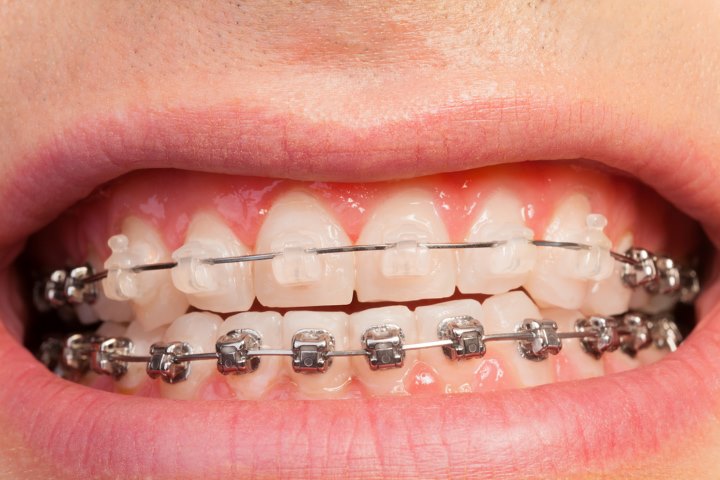
- Orthodontic Treatment Plan
Metal braces take much longer than clear ones to correct malalignment. On average, they take anywhere from 1 to 3 years based on the complexity of the problem. Following these braces, you will have to wear retainers to keep your teeth from moving back.
- Comfort of wear
- Metal frames on your teeth may not be your definition of a comfortable experience. On top of that, you have a lot of dietary restrictions as some foods may damage the braces. With removable aligners, you can just remove them during meals.
- Oral Hygiene
The metal parts in conventional braces make it very difficult for the patient to clean thoroughly.
Compared to traditional metal braces, clear ones are easier to take care of. Teeth with braces that are clear often come with good oral health and hygiene.
Takeaway
Through this educational article, we hope you were able to learn crucial details about invisible or clear-type braces. If you’re looking to straighten your teeth but don’t want to go through the hassles of getting conventional braces, clear braces are your saving grace.
Whether they are made of clear attachments or low-visibility plastics, clear braces greatly elevate your teeth straightening experience. Know your clear braces well and decide which one is the right one to meet your specific dental needs. Brace yourself as you now join in on the braces crusade with a stylish flare – beautiful, straight teeth.
FAQ
Do teeth with clear braces hurt?
While you may experience some discomfort right at the beginning of your treatment, any tenderness of your gums and teeth should subside in a few days.
Can I keep my Invisalign aligners out when I sleep?
Remember to never let your clear Invisalign devices dry out as it can produce undesirable results. Keep them in their case or submerge them in water when you aren’t using them.
Are clear-type braces as strong as metal braces?
While clear aligners may not be as strong as their metal counterparts, they are just as effective. Due to their differences in materials, they may just take longer to correct your teeth misalignments.

